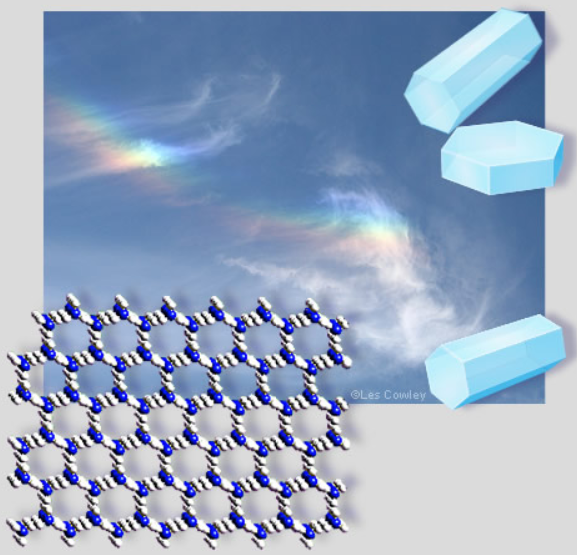Cloud Crystals & Halos
Cloud Crystals & Halos: A Mesmerizing Display of Atmospheric Optics
Cloud crystals and halos are a captivating phenomenon that can be observed throughout the year, from the tropics to the poles. These enchanting displays are created by ice crystals found in cirrus clouds, which are located at altitudes ranging from 3 to 6 miles (5 to 10 km) above the Earth's surface. Interestingly, these clouds are always cold, regardless of their geographic location.
In addition to cirrus clouds, halos can also be formed by ice crystals near ground level during extremely cold weather. This phenomenon is known as "diamond dust." Similar to precious jewels, ice crystals have the ability to refract and reflect sunlight as it passes through their faces. This refraction and reflection result in the creation of mesmerizing shafts of light that give rise to the phenomenon we know as halos.
What makes halos so fascinating is the fact that regardless of their size or shape, all ice crystals possess identical interfacial angles. This uniformity in crystal angles is not a mere coincidence; it stems from a deeper order at the molecular level. In ice, individual water molecules are intricately linked together and arranged in a regular lattice structure. It is this submicroscopic order and symmetry that ultimately gives rise to the beautiful forms and symmetries of halos in the sky.
To fully appreciate the complexity and beauty of halos, it is important to understand their various forms and classifications. Halos can take on different shapes and patterns, each with its own unique characteristics. Some of the most common types of halos include:
-
22-Degree Halo: This is the most frequently observed halo and forms a circular ring around the Sun or Moon. It occurs due to the refraction and reflection of sunlight by hexagonal ice crystals.
-
Circumzenithal Arc: Often referred to as the "upside-down rainbow," this halo appears as an arc of colors positioned above the Sun. It is caused by sunlight passing through horizontally oriented ice crystals.
-
Supralateral Arc: This halo forms a bright arc extending horizontally from the Sun or Moon. It occurs when sunlight is refracted and reflected by plate-shaped ice crystals.
-
Parhelic Circle: This halo appears as a circle of light surrounding the Sun at the same altitude. It is created by the reflection and refraction of sunlight by randomly oriented ice crystals.
The study of atmospheric optics and the formation of halos continues to intrigue scientists and enthusiasts alike. While our understanding of these phenomena has greatly advanced, there is still much to learn about the intricate processes occurring within ice crystals and their role in creating these mesmerizing displays.
As we gaze upon the skies, it is awe-inspiring to think about the microscopic order and symmetry present within ice crystals. Each crystal, regardless of its size or location, contributes to the collective glimmers that form halos. The constancy of crystal angles is a testament to the underlying molecular order and the intricate dance of light within our atmosphere.
Next time you find yourself outdoors on a clear day, take a moment to look up and appreciate the intricate beauty of cloud crystals and halos. These ethereal displays remind us of the astonishing wonders that exist in our natural world and inspire us to delve deeper into the captivating field of atmospheric optics.

Halos can be seen all the year round from the tropics to the poles. Ice crystals in cirrus clouds produce them. The clouds are 3 - 6 miles (5 to 10 km) high and are always cold regardless of their location.
In very cold weather halos are also formed by crystals in air close to ground level, called diamond dust.
Ice crystals behave like jewels. Sunlight passing between their faces is refracted and reflected to send shafts of light in particular directions. Halos are the collective glints of millions of crystals.
Regardless of their overall proportions, all ice crystals have identical interfacial angles. It is this constancy which gives regular and predictable halos.
Why are the crystal angles always the same? The constancy comes from a deeper order at a molecular scale. In ice, individual water molecules are linked together and arranged in a regular lattice.
This submicroscopic order and symmetry gives us the halo forms and symmetries of the skies.
Note: this article has been automatically converted from the old site and may not appear as intended. You can find the original article here.
Reference Atmospheric Optics
If you use any of the definitions, information, or data presented on Atmospheric Optics, please copy the link or reference below to properly credit us as the reference source. Thank you!
-
<a href="https://atoptics.co.uk/blog/cloud-crystals-halos/">Cloud Crystals & Halos</a>
-
"Cloud Crystals & Halos". Atmospheric Optics. Accessed on April 25, 2024. https://atoptics.co.uk/blog/cloud-crystals-halos/.
-
"Cloud Crystals & Halos". Atmospheric Optics, https://atoptics.co.uk/blog/cloud-crystals-halos/. Accessed 25 April, 2024
-
Cloud Crystals & Halos. Atmospheric Optics. Retrieved from https://atoptics.co.uk/blog/cloud-crystals-halos/.